Computational Receptor Biology – Gloriam Group
David Gloriam’s group identifies mechanisms, structures and ligands of G protein-coupled receptors (GPCRs) – the main mediators of human signalling and drug responses – and develop the field’s main online database, GPCRdb (see video and GPCRdb.org).
GPCR activation mechanisms across classes and macro/microscales
Nature Structural & Molecular Biology. Accepted
GPCRdb in 2021: Integrating GPCR sequence, structure and function
Nucleic Acids Research. 2021
Discovery of Human Signaling Systems: Pairing Peptides to G Protein-Coupled Receptors.
Cell. 2019
An online resource for GPCR structure determination and analysis.
Nature Methods. 2019
Trends in GPCR drug discovery: new agents, targets and indications
Nature Reviews Drug Discovery. 2017 [Citations: 1,065]
From collaborations
Structural insights into the lipid and ligand regulation of serotonin receptors
Nature. 2021
Structure of the class D GPCR Ste2 dimer coupled to two G proteins.
Nature. 2020
Combinatorial expression of functionally distinct GPCR isoforms can diversify receptor signalling
Nature. 2020
Pharmacogenomics of GPCR drug targets
Cell. 2018 [Citations: 329]
Selectivity determinants of GPCR–G-protein binding
T Flock, AS Hauser, N Lund, DE Gloriam, S Balaji, MM Babu
Nature. 2017 [Citations: 217]
Our group is mainly funded by grants from external foundations and councils. In recent years we have obtained major grants (> 0.3 million DKK) from Alfred Benzon Foundation, European Research Council, Independent Research Fund Denmark, Lundbeck Foundation, Novo Nordisk Foundation and Stiftelsen Olle Engkvist Byggmästare.
Lundbeck Foundation Personalised Medicine grant
2018.12.17
Hans Bräuner-Osborne (main applicant), David Gloriam and Alexander Hauser have received a DKK 10 million Personalised Medicine grant from the Lundbeck Foundation for the project: Advancing personalised medicine for psychiatric diseases through integrative GPCR Pharmacogenomics. The project aims to find out how genetic variants in GPCRs affect the usage of drugs treating psychiatric disorders.

Novo Nordisk Foundation Ascending Investigator
2018.03.28
Major grant on GPCR biased signalling.
David Gloriam has received DKK 10 million (€ ~1,3 M) Hallas-Møller Ascending Investigator grant from the Novo Nordisk Foundation (an ERC Consolidator-like Danish grant) for the project: GPCR Biased Signalling: Illuminating the Pathways to Function and Disease. The project aims to find out how just one cell-surface receptor can elicit vastly different biological, therapeutic or adverse effects when activated by natural, medicinal or abused substances. The Gloriam group will develop a new database resource to consolidate this new research field and conduct molecular modelling to select receptor targets and identify molecular mechanisms and substances.

EU PhD training network
2018.02.23
Towards biased ligands for the serotonin 5-HT2A receptors - a target of CNS drugs and hallucinogens,
SAFER is the first European research platform to gain a molecular understanding and improve selectivity in the stimulation of the serotonin 5-HT2A receptor – the primary target for many CNS-related disorders and hallucinogens. SAFER will design and prepare ligands for the receptor, generate and cross-interpret pharmacology and crystallographic data, and construct computational mechanistic models and databases.
The SAFER network comprises five PhD students in pharmacology, chemistry, crystallography, computational drug design and scientific database development; first receiving 1-1,5 years joint training at the University of Copenhagen (Denmark) followed by industrial research at Enamine (Kiev, Ukraine) or SARomics (Lund, Sweden).
SAFER is coordinated by Jesper Kristensen at the University of Copenhagen who leads a chemistry group that has developed serotonin 5-HT2A receptor ligands being used as tracers for human brain imaging for diagnosis and evaluation of treatments.
PhD to Christian Munk
2016.11.01
PhD fellowship to GPCRdb lead developer.
GPCRdb lead developer Christian Munk received a PhD grant from the Lundbeck Foundation for the project: GPCR-G protein complex conformations – Structural stabilisation in selective
Scholarship to Anders Nielsen
2016.01.01
12-month research scholarship.
Anders Nielsen got a 12-month research scholarship from The Danish Council for Independent Research | Medical Sciences to identify orphan receptor tool compounds.
GPCR Consortium grant
2015.12.01
Towards tools for structure determination.
The group became a funded member of the GPCR Consortium headed by Ray
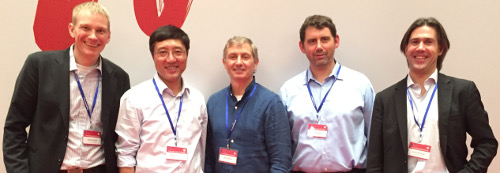
Mutation annotation grant
2015.05.01
Towards database of ligand-affecting GPCR mutations.
365,000 SEK received from Stiftelsen Olle Engkvist Byggmästare to annotate mutant data for the GPCRdb.

Lundbeck Foundation Fellow
2015.01.01
Orphan receptor ligand identification.
David Gloriam received a 10 million DKK Lundbeck Foundation Fellowship for the project "Orphan Receptor Ligands And Signals - Keys to Physiological Functions And Drug Discovery.

ERC Starting Grant
2014.12.01
Orphan receptor ligand identification.
David Gloriam received a 1.5 million EUR ERC Starting Grant for the project "DE-ORPHAN - Determination of Orphan Receptor Physiological Agonists and sigNals"
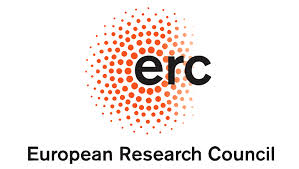
Albert J. Kooistra receives the MGMS Frank Blaney Award
2021.11.27

David Gloriam receives big data prize from the Danish Royal Academy of Sciences and Letters
2021.10.08

Alexander S. Hauser receives Bachem Award for Peptide Science
2021.03.26

Alexander Hauser receives HC Ørsted research talent prize
2019.08.14

Professor inauguration
09.05.2019
Inauguration of David Gloriam as Professor. … »
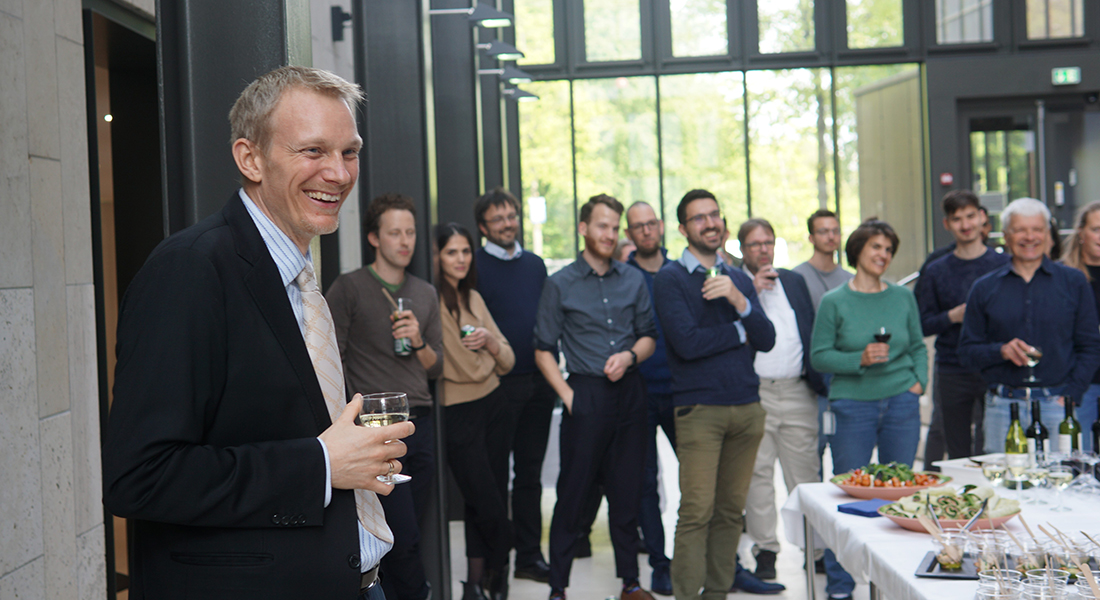
Crystal refinement bronze
15.11.2016
Bronze prize in crystal structure refinement.
Louise Nikolajsen got
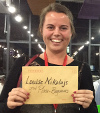
Wikipedia gold
11.07.2016
Gold prize in Wikipedia competition.
The International Society for Computational Biology (ISCB) announces competitions to improve the coverage on Wikipedia of any aspect of computational biology. In the last WikiProject competition PhD student Alexander S. Hauser has been awarded 1st and 2nd prize awards with an in-depth update of the molecular docking Wikipedia page as well as Wikidata entry.

Oral & poster awards
01.06.2016
2nd Central European Biomedical Congress.
Stefan Mordalski and Gáspár Pándy-Szekeres received awards for their oral and poster presentations, respectively, at the 2nd Central European Biomedical Congress, in Krakow, Poland.
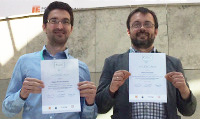
GPCR modelling gold
01.08.2014
Best 5-HT1B model in global competition.
1st and 3rd places in the GPCR Dock competition for structure
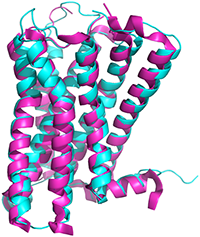
GPCRdb accelerates data-driven receptor research
2021 01 18
GPCRdb accelerates data-driven receptor research
Discovery of new hormone-receptor signalling systems
2019.10.31
Press release and video
Ultra-large virtual screening for drugs
2019.02.06
News & views article and podcast
Press release: GPCR structure determination resource
2019.01.23
Online tools to determine GPCR 3D structures.
The first web-based tool to determine GPCR 3D structures (Nature Methods) - Eng
Press release: 5-HT2C structure
2018.02.01
Shedding insight on GPCR-ligand polypharmacology.
Polypharmacology and 3D structure of the serotonin 5-HT2C receptor (Cell) - Eng
Video on GPCR pharmacogenomics
2018.01.11
From the Cell article on pharmacogenomics of GPCR drug targets. … »
Press release: GPCR pharmacogenomics
2017.12.15
Genetic variation in GPCR drug targets.
Pharmacogenomics of GPCR drug targets (Cell) - Eng1, Eng2 & Dan
Press release: GPCR drug discovery
2017.10.31
Trends for drugs, clinical trials and indications.
Trends in GPCR drug discovery (Nat Rev Drug Discov) - Eng & Dan
Press release: G protein selectivity
2017.05.11
Determinants of GPCR-G protein coupling.
Receptor signalling: GPCR - G protein selectivity (Nature) - Eng & Dan
Intro to the GPCRdb database
2015.06.01
Popular scientific article about the GPCRdb database.
Video on orphan receptor ligand identification
2015.01.01
Video made in relation to the award of the Lundbeck Foundation Fellowship to David Gloriam. English: … »
Research
Biased Signalling
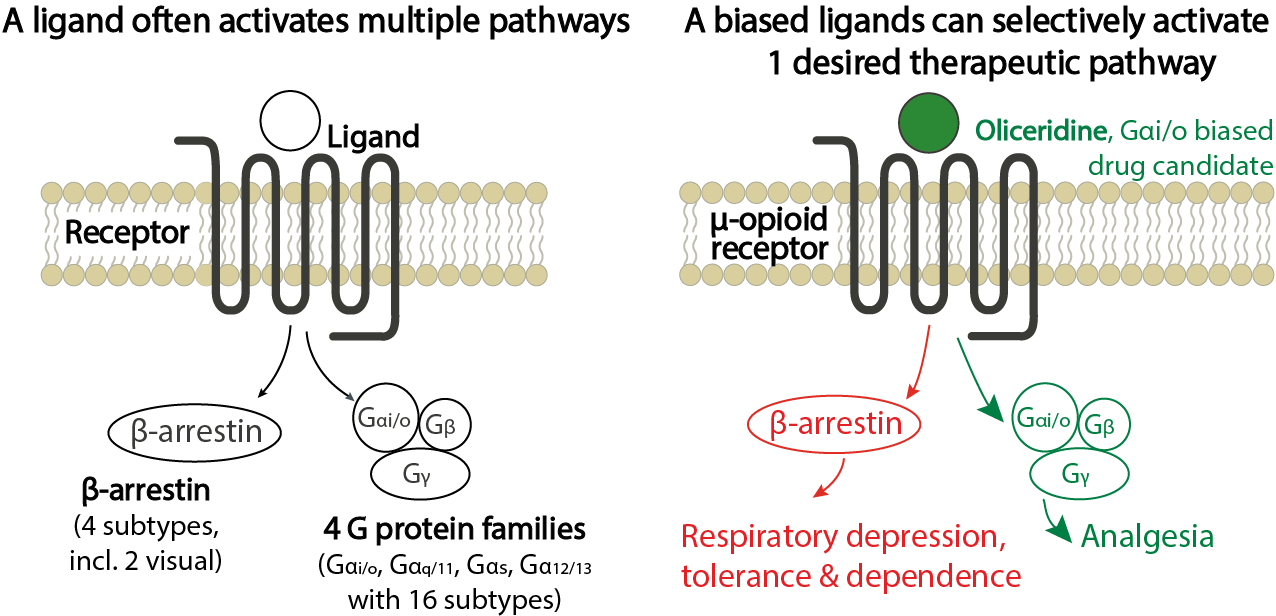
1. Most GPCR ligands activate multiple signalling pathways spanning four G protein classes: Gq/11, Gi/o, Gs and G12/13 with 16 subtypes. Furthermore, arrestin proteins mediate GPCR signalling, desensitisation and internalisation.
2. A biased ligand preferentially actives only one singnalling pathway. A new candidate analgesic drug, oliceridine selectively stimulates the μ-opioid receptor Gi/o pathway, but lacks the ß-arrestin mediated constipation and respiratory depression.
Drug development has an 86% failure rate –mainly due to insufficient efficacy or to side effects. For GPCRs this could be solved by ‘biased ligands’ which re-route cellular pathways to therapeutic actions away from side effects. However, this huge potential is inaccessible because few GPCRs have biased ligands and we do not yet know the molecular mechanisms to rationally design them.
Biased ligands: We will create a database of known biased ligands and identify new such ligands through computational drug design. A PhD training network, SAFER has set out to identify biased ligands for the serotonin 2A receptor (5-HT2A), which mediates the effect of recreational drugs, e.g. LSD and agents in clinical trials for treatment-resistant depression and anxiety. A Novo Nordisk Foundation Ascending Investigator grant focuses on the free fatty acid receptor 4 – a target for diabetes and inflammation – will also pharmacologically profile the signalling of known reference ligands and drugs to identify signalling bias. Going forward, we would like to take on a wider challenge to build a virtual screening pipeline to identify novel ligands with signalling bias for many more GPCRs.
Pathway effects: We will make an online atlas of the physiological and therapeutic effects of individual GPCR signalling pathways, thereby providing the rationale for which pathways to target in drug discovery and receptor function studies. So far, few such effects are known. However, much more such data will soon become available, from e.g. the new European research network on signal transduction, ‘ERNEST’ and as more clinical trials evaluate biased candidate drugs. We are also exploring computational drug design to identify G protein/b-arrestin inhibitors that would constitute very valuable tools to map (patho)physiological pathways.
Structures and mechanisms: We plan to (application pending) to develop protein engineering and online tools to ease the generation of GPCR structures bound to G proteins and biased ligands, which could elucidate molecular mechanisms to design biased tool compounds and drugs.
Computational drug design
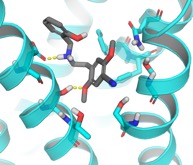 |
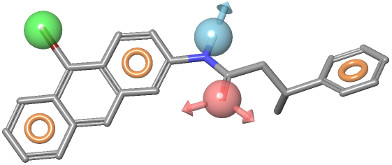 |
Left) Docking of a ligand into the binding site of a receptor target structure provides a model of the mode-of-action, guiding further medicinal chemistry optimisation and pharmacological validation by mutagenesis.
Right) Pharmacophore elements are placed based on known ligands to give a 3D representation of the features important for target interaction and activity, and are used to identified new ligands with other chemical structures.
"Today the computer is just as important a tool for chemists as the test tube. Simulations are so realistic that they predict the outcome of traditional experiments"
- Finale of the motivation for the
- 2013 Nobel Prize in Chemistry
"Today, computational models are integral for the rationalization of experimental data and generation of hypotheses for new studies. In the Gloriam group, we combine bioinformatics, chemoinformatics and computational chemistry in computational drug design at GPCRs. We also develop new methods for virtual screening, chemogenomics and design of target-directed focused screening libraries.
The work has led to the identification of novel ligands for the chemokine, glutamate, histamine and serotonin receptors. It is highly interdisciplinary, building on collaborations with Medicinal Chemistry and Molecular Pharmacology groups at the Department of Drug Design and Pharmacology, as well as several international labs.
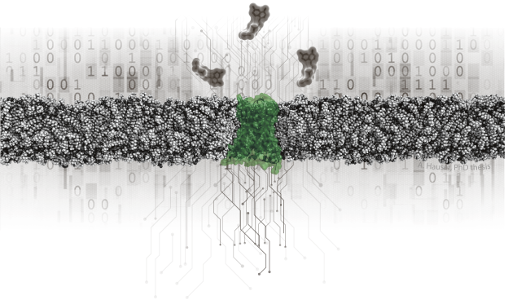
The explosion of biomedical data in genomics, structural biology and pharmacology provides new opportunities to deepen our understanding of human physiology and disease. We integrate these data with innovative computational tools to gain novel insights into receptor biology. Our strength is the combined expertise in selected biological systems with the integration of diverse often unique datasets and hypotheses. The common objective of our projects is to tackle some of the currently most sought-after questions in the GPCR field.
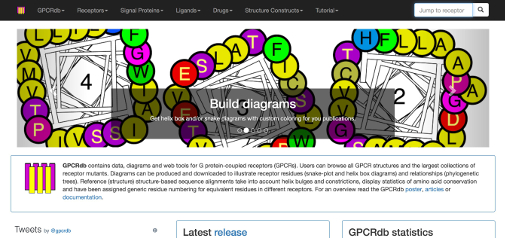
|
GPCRdb serves over 3000 researchers every month. GPCRdb features reference data, web tools and visualisation diagrams enabling science in the wider GPCR community. It also holds web-based tools to design new experiments - a mutation design tool for ligand binding sites and a construct design tool for structure determination. |
More information
Visit GPCRdb
NC-IUPHAR newsletter (pages 3-4)
GPCRdb poster
Popular scientific article (in Danish)
Selected Publications
GPCRdb in 2018: Adding GPCR structure models and ligands
Pándy-Szekeres G, Munk C, Tsonkov T, Mordalski S, Harpsøe K, Hauser AS, Bojarski AJ and Gloriam DE
Nucleic Acids Research. 2017
Munk C, Harpsøe H, Hauser A, Isberg V, and Gloriam DE
Integrating structural and mutagenesis data to elucidate GPCR ligand binding.
Curr Opin Pharmacol, 2016 Jul 28;30:51-58
Munk C, Isberg V, Mordalski S, Harpsøe K, Rataj K, Hauser A, Kolb P, Bojarski AJ, Vriend G, and Gloriam DE
GPCRdb: The G protein-coupled receptor database - An introduction.
Br J Pharmacol, 2016 Jul;173(14):2195-207
Isberg V, Mordalski S, Munk C, Rataj K, Harpsøe K, Hauser AS, Vroling B, Bojarski AJ, Vriend G, and Gloriam DE
GPCRdb: an information system for G protein-coupled receptors
Nucleic Acids Res, 2016 Jan 4;44(D1):D356-64
Isberg V, de Graaf C, Bortolato A, Cherezov V, Katritch V, Marshall FH, Mordalski S, Pin JP, Stevens RC, Vriend G, Gloriam DE.
Generic GPCR residue numbers - aligning topology maps while minding the gaps.
Trends Pharmacol Sci. 2015 Jan;36(1):22-31.; PMID: 25541108
Isberg V, Vroling B, van der Kant R, Li K, Vriend G and Gloriam DE
GPCRDB: information system for G protein-coupled receptors
Nucleic Acids Res. 2014 Jan 1;42(1); PMID: 24304901

GPCR structures are invaluable for receptor function studies and for rational drug design. Technological advances in X-ray crystallography and cryogenic electron microscopy (cryo-EM) have led to an explosion of structures covering all major GPCR classes and diverse ligands (see latest statistics). However, there are still no structures for the vast majority of the 398 non-olfactory GPCRs and technological limitations remain that restrict which ligand complexes can be attained.
In the last years, the Gloriam group has set up GPCR crystallography and cryo-EM in collaboration with structural biology professors Jette S. Kastrup and Michael Gajhede. The projects aim to cover more receptors and ligands, including in-house medicinal chemistry targets and biased ligands. We are part of a structural biology network, ISBUC at the University of Copenhagen. We collect data at the new state-of-the-art synchrotron MAX IV in Lund (X-ray crystallography), two national cryo-EM core facilities and a number of international resources.
The Gloriam group also maintain an online resource for GPCR structure determination based on all published structures. The major features include design of new receptor constructs and browsing of experimental methods and reagents (Structure Constructs section in https://gpcrdb.org). The GPCRdb database also features a number of tools to analyse existing structures and, where lacking, structure models for nearly all GPCRs in the inactive, active and intermediate states.
Group members
| Name | Title | |
|---|---|---|
| Andreassen, Søren Norge | Academic Research Staff |
|
| Caroli, Jimmy | Assistant Professor |
|
| Durdevic, Anja | Master Thesis Student |
|
| Henseler, Jascha | PhD Fellow |
|
| Kastrup, Jette Sandholm Jensen | Professor |
|
| Kulkarni, Yashraj | Postdoc |
|
| Pacalon, Jody Sullivan | Postdoc |
|
| Pedersen, Eva-Marie Lucin Mokdasi A | Laboratory Technician |
|
| Pándy-Szekeres, Gáspár | Academic Research Staff |
|
| Rodriguez Espigares, Ismael | Academic Research Staff |
|
| Simonyan, Arman | PhD Fellow |
|
| Sánchez Lorente, Javier | Academic Research Staff |
|
| Xiao, Binghan | PhD Fellow |
|
| Zhang, Oulin | Visiting Student |
|

